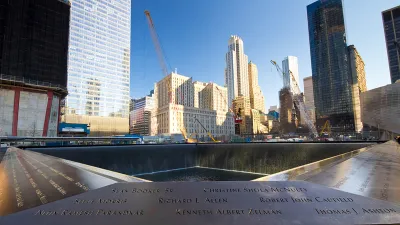The grand opening of the 9/11 memorial and museum is derided by critics as a cold, uninviting public space, and 'ritualizing grief on a loop'

On May 15, 2014 President Obama gave solemn remarks of remembrance for the families lost and reminded all once again of the terrible tragedies that opened a national, even international, wound.
New York Times architecture critic Michel Kimmelman reviews the newly dedicated museum, offering reverence amidst reproach for the entire memorial and museum. Kimmelman, who has visited the site at multiple times of the day on several occasions since its opening, agrees with the site as one of poignant national nostalgia: "This is a place for remembrance, but it’s not like [other national memorials in DC]. The site of the Sept. 11 memorial is not singularly devoted to those who died. It also serves as the forecourt for an office development and as public space for Lower Manhattan. The neighborhood was a casualty, too, along with the rest of New York."
The primary issue, joined by several commentaries authored on the space including The Washington Post's Philip Kennicott, insists that the design incites fear and evokes dread rather than engages and enlivens. Kennicott scathes the entire project, saying the designs "subsume educational material in an emotional narrative, punctuated by over-scaled, emotionally fraught objects, amplified by every architectural, cinematic, literary and religious tool available."
"The place doesn’t feel like New York. It feels like a swath of the National Mall plunked in downtown Manhattan: formal, gigantic, impersonal, flat, built to awe, something for tourists," Kimmelman asserts in his piece, discussing minute details and calling out a flawed design process hijacked by politics. "I admire Snohetta. Not this building, though: from the outside, a mirrored glass-and-steel jumble of tilting planes with a trapezoid roof, poorly detailed, presenting a cold face to the south fountain…The place doesn’t do much to celebrate the city’s values of energy, diversity, tolerance openness and debate." Kimmelman furthermore extolls the public seating as 'severe' and laments the landscaping, which 'thwarts the natural flow of pedestrian traffic.'
Is the national space created to memorialize the day that changed everything for many of our readers a designed dead space?
FULL STORY: Finding Space for the Living at a Memorial

Analysis: Cybertruck Fatality Rate Far Exceeds That of Ford Pinto
The Tesla Cybertruck was recalled seven times last year.

National Parks Layoffs Will Cause Communities to Lose Billions
Thousands of essential park workers were laid off this week, just before the busy spring break season.

Retro-silient?: America’s First “Eco-burb,” The Woodlands Turns 50
A master-planned community north of Houston offers lessons on green infrastructure and resilient design, but falls short of its founder’s lofty affordability and walkability goals.

Test News Post 1
This is a summary

Analysis: Cybertruck Fatality Rate Far Exceeds That of Ford Pinto
The Tesla Cybertruck was recalled seven times last year.

Test News Headline 46
Test for the image on the front page.
Urban Design for Planners 1: Software Tools
This six-course series explores essential urban design concepts using open source software and equips planners with the tools they need to participate fully in the urban design process.
Planning for Universal Design
Learn the tools for implementing Universal Design in planning regulations.
EMC Planning Group, Inc.
Planetizen
Planetizen
Mpact (formerly Rail~Volution)
Great Falls Development Authority, Inc.
HUDs Office of Policy Development and Research
NYU Wagner Graduate School of Public Service


























